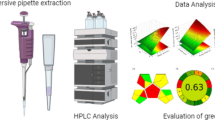Abstract
Highly degraded citrus fruit juices collected during a quality control investigation of the Italian Ministry of Agricultural Alimentary and Forestry Policies (MIPAAF) were analyzed for verifying their technological history. The analyzed samples were fermented black fluids stated as degraded first strength juices, in order to justify communitarian aids. Polymethoxylated flavones (PMFs) detection of solid phase extracted (SPE) purified samples provided clean chromatograms and good separation of compounds of interest using high performance liquid chromatography coupled with diode array and mass spectrometry HPLC–PDA/ESI–MS/MS. Since the PMFs concentration is elevate in peel flavedo, it is directly correlated with juice extraction strength. Results showed that all analyzed samples presented a PMFs concentration ranging from two to eight times first strength juices, not respecting the minimum quality requirements of the European regulatory framework.





Similar content being viewed by others
References
Harborne JB (1994) Flavonoids: advances in research since 1986. Chapman and Hall, London
Miyake Y, Yamamoto K, Morimitsu Y, Osawa T (1997) Isolation of C-glucosylflavone from lemon peel and antioxidative activity of flavonoid compounds in lemon fruit. J Agric Food Chem 45:4619–4623
Leuzzi U, Caristi C, Panzera V, Licandro G (2000) Flavonoids in pigmented orange juice and second-pressure extracts. J Agric Food Chem 48:5501–5506
Ooghe WC, Ooghe SJ, Detavernier CM, Huyghebaert A (1994) Characterization of orange juice (Citrus sinensis) by polymethoxylated flavones. J Agric Food Chem 42:2191–2195
Marini D, Balestrieri F (1995) Multivariate analysis of flavanone glycosides in Citrus juices. Ital J Food Sci 7:255–264
Dandana W, Jian W, Xuehui H, Yinga T, Kunyia N (2007) Identification of polymethoxylated flavones from green tangerine peel (Pericarpium Citri Reticulatae Viride) by chromatographic and spectroscopic techniques. J Pharm Biomed Anal 44:63–69
Manthey JA, Buslic BS (2003) HPLC-MS analysis of methoxylated flavanones in orange oil residue. Proc Florida State Hortic Soc 116:410–413
Pupin AM, Dennis MJ, Toledo MCF (1998) Polymethoxylated flavones in Brazilian orange juice. Food Chem 63:13–518
Mouly P, Gaydou EM, Auffray A (1998) Simultaneous separation of flavanone glycosides and polymethoxylated flavones in citrus juices using liquid chromatography. J Chrom A 800:171–179
Author information
Authors and Affiliations
Corresponding author
Rights and permissions
About this article
Cite this article
Scordino, M., Sabatino, L., Traulo, P. et al. HPLC–PDA/ESI–MS/MS detection of polymethoxylated flavones in highly degraded citrus juice: a quality control case study. Eur Food Res Technol 232, 275–280 (2011). https://doi.org/10.1007/s00217-010-1386-4
Received:
Revised:
Accepted:
Published:
Issue Date:
DOI: https://doi.org/10.1007/s00217-010-1386-4




